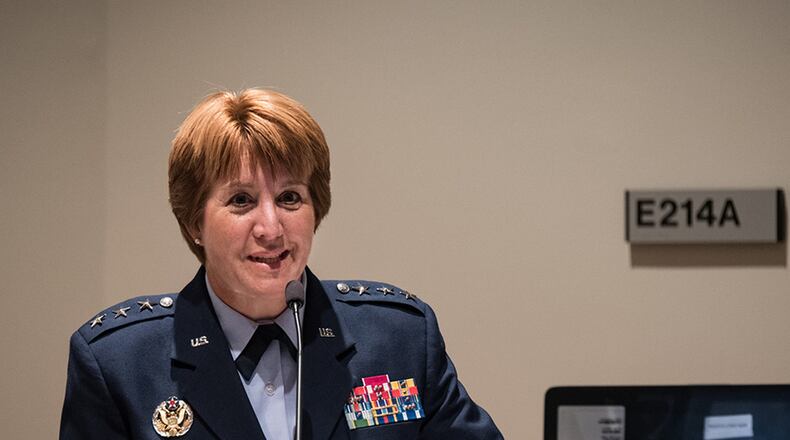The two-day event – part of USAFSAM’s larger centennial celebration – honored the past, present and future of aeromedical evacuation, according to Elizabeth Miller, deputy chair of USAFSAM’s En Route Care Training Department, and included guest speakers, an air ambulance dedication, a reunion dinner, a memorial wreath presentation, tours and poster sessions and a graduation ceremony.
Lt. Gen. Dorothy Hogg, U.S. Air Force surgeon general, kicked off the event by thanking the audience for the opportunity to celebrate a remarkable milestone of what she calls “disruptive innovation.”
“Through your disruptive innovation, all of you flight medics – nurses, surgeons and technicians – have made aeromedical evacuation what it is today,” she said. “The en route care paradigm has evolved dramatically since 1943. We used to bring a doctor by air to a patient and then move them both via ground transportation. Then we transported patients by air – if they were stable – to a point of care. Now we essentially have hospitals in the back of airplanes. Aeromedical evacuation and critical care air transport teams are constantly redefining ‘care in the air’ and saving lives in the process.”
Other speakers throughout the day represented different aspects of aeromedical evacuation, including flight nurses, a patient, a technician, an on-scene medical commander and a member of a critical care air transport team. Though the experiences they shared were unique, the speakers all had common messages about commitment, compassion, readiness and appreciation.
One of the speakers, Harriett Neill, was a flight nurse who completed her training at USAFSAM in 1974, was assigned to Clark Air Base in the Philippines, and was then sent to Vietnam for Operation Babylift. During the evacuation flight she was working on April 5, 1975, the cargo door of the C-5 malfunctioned, forcing a crash landing. Despite sustaining their own injuries, Neill and the rest of the crew remained dedicated to saving every child that survived the crash.
“Your training kicks in,” Neill said. “We were ordinary people who, when faced with extraordinary circumstances, were able to continue our professional and humanitarian mission thanks to the remarkable training we received at USAFSAM. Part of that training is also a promise to our patients. Indeed, when we saw our own evacuation crew show up following the crash, I learned first-hand the relief and appreciation our patients feel when they see us.”
The first day of the anniversary event also included the dedication of a Curtiss JN-4 “Jenny,” which was instrumental in preparing the military for an aeromedical evacuation mission.
Although the French army and others had experimented earlier, it was not until 1918, the last year of World War I, when the U.S. Army first recognized the value of air transport of wounded soldiers. In that year, Maj. Nelson E. Driver and Capt. William C. Ocker converted a “Jenny” bi-plane into an air ambulance. They modified the open rear cockpit to accommodate a standard Army stretcher, holding one patient in a semi-reclined position. This success led to an order directing all military airfields to have at least one air ambulance for the duration of the war.
As more men and women followed in the footsteps of those Jenny pioneers, aeromedical evacuation evolved in both capability and capacity. As wartime activities decreased, however, there were fewer opportunities for medics to participate in acute care and trauma medicine – which had the potential to impact the sustainment of readiness skills necessary for future operations. To combat that risk, the School of Air Evacuation was created at Bowman Field, Kentucky, in 1942.
Col. Alden Hilton, USAFSAM commander and a self-described student of history, described the school’s beginnings.
“Prior to 1942, patient evacuations were conducted by crews with essentially no training,” he said. “The formal charge from the War Department was to train medics in the ‘art and science of moving patients by air.’ The first class, consisting of 30 flight nurses and medical technicians, graduated on Feb. 18, 1943. The following year, the School was transferred to be part of USAFSAM, and we have been dedicated to the AE mission ever since, making a heartfelt commitment to our patients and their families. We teach our medics to treat patients on the front lines of combat and to care for them while being evacuated by air to hospitals in safe areas where they can receive definitive care.”
USAFSAM’s En Route Care Training Department – partnering with the 375th Operations Group, Det 4 – now educates medical professionals in trauma, aeromedical evacuation and international medicine, including flight nurse and aeromedical technician training, Critical Care Air Transport Team training, Tactical Critical Care Evacuation Team training, Centers for Sustainment of Trauma and Readiness Skills courses, and infectious disease readiness training.
Even after state-of-the-art, world-class training, however, aeromedical evacuation missions are not without risk – as evidenced by Neill’s experience. Day two of the anniversary event included a wreath-laying ceremony in remembrance of the flight nurses and technicians who have lost their lives in the line of duty.
Following the wreath laying, the event ended with a look to the future. The latest class of nurses and technicians graduated from their Aeromedical Evacuation Initial Qualification Course, taking the flight nurses’ creed to fly into harm’s way to pick up wounded warriors and bring them home to their families. The graduation harkened back to Hogg’s comments the day prior.
“What now?” she asked. “Do we stand on our past accomplishments and say, ‘This is good enough’? Do we pat ourselves on the back and say, ‘Good job’? No. Today is not the day we say, ‘Good enough.’ Today is the day we say ‘What if…?’ and define the future of aeromedical evacuation. Congratulations on 75 years of disruptive innovation. I look forward to 75 more.”
About the Author
